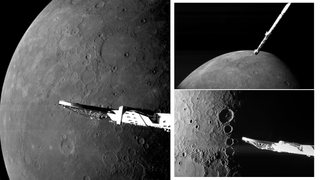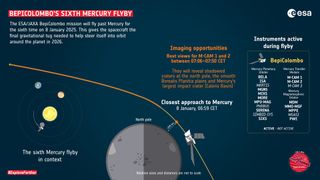Mercury, the smallest planet in our solar system, often goes unnoticed. But recent images from the BepiColombo spacecraft's 6th flyby are changing that.
The European-Japanese BepiColombo mission offers new, stunning views of Mercury. These images reveal details never seen before. They capture the planet's craters, ridges, and unique features. BepiColombo's flyby brings Mercury into sharp focus, making it a subject of great interest.
This mission aims to study Mercury's surface and environment. The latest images add to our understanding, showing the planet in a new light. They excite scientists and space enthusiasts alike. Join us as we explore these breathtaking images. Discover the beauty and mystery of Mercury, our solar system's innermost planet.
Bepicolombo Mission
Bepicolombo is a mission to explore Mercury. This mission will help us learn more about this planet. It uses two spacecraft to gather data. These spacecraft are the Mercury Planetary Orbiter and the Mercury Magnetospheric Orbiter. They will study Mercury's surface and magnetic field. The mission started in October 2018. It aims to arrive at Mercury in December 2025. These spacecraft have many instruments to take photos and measure data.
Two big space agencies work on the Bepicolombo mission. One is the European Space Agency (ESA). The other is the Japan Aerospace Exploration Agency (JAXA). ESA builds and manages the Mercury Planetary Orbiter. JAXA builds and manages the Mercury Magnetospheric Orbiter. Both agencies work together for mission success. They share data and findings with scientists worldwide. This collaboration helps us understand Mercury better.

Credit: www.space.com
The 6th Flyby
The Bepicolombo spacecraft's goal is to study Mercury. The 6th flyby captured amazing images. These images help scientists learn more. They study Mercury's surface and environment. Data from the flyby will reveal new details. Scientists compare these with old data. The mission aims to understand Mercury better. This flyby is one step in the mission.
The spacecraft followed a precise path. It flew close to Mercury. The path allowed it to take clear pictures. The flyby used gravity to adjust its route. Each adjustment brings it closer to Mercury. This method saves fuel. It also ensures the spacecraft stays on course. The trajectory is carefully planned. Every detail is important for success.
Impressive Images
The Bepicolombo spacecraft has captured stunning images of Mercury. The spacecraft uses advanced cameras to take these pictures. These images are very clear. Scientists worked hard to make sure the pictures are perfect. The cameras on the spacecraft are very powerful. They can see details on Mercury's surface. Each image is checked for quality. This process ensures the best pictures are shared with us.
The images show many amazing features of Mercury. We can see craters and valleys. Some craters are very large. Other craters are smaller. These images help us learn more about Mercury. Scientists study the images to find new things. They look for patterns in the surface. These images are very important for space research.

Credit: www.reddit.com
Mercury's Surface
Mercury's surface is covered with craters. These craters are caused by meteoroid impacts. The planet has large plains and high cliffs. Iron and magnesium-rich minerals are found on the surface. Silicate minerals are also present. The surface reflects very little light. It is similar to our Moon's surface.
Mercury has many interesting geological features. There are huge cliffs called lobate scarps. These cliffs formed as the planet cooled and shrunk. Smooth plains are found between craters. These plains were made by lava flows. Hollows are small, shallow depressions on the surface. They have bright edges. Scientists are still studying these features.
Scientific Discoveries
The Bepicolombo spacecraft sent back stunning images of Mercury. These images show craters and ridges. Scientists are excited. Mercury's surface is rocky and full of surprises. It looks different from Earth. There are many questions to answer. Why are the craters so big? How old are the rocks? The images offer clues.
More study of Mercury will help scientists learn more about the planet. They plan to use new tools and technology. These studies will help us understand other planets too. Mercury's extreme temperatures will be explored. This research is important. It can help us learn about the Solar System's history. The findings can guide future missions. Mercury is a mystery waiting to be solved.

Credit: www.space.com
Technological Achievements
Bepicolombo carries many advanced instruments. These tools help study Mercury closely. They include cameras, spectrometers, and magnetometers. The cameras take high-quality pictures of Mercury's surface. Spectrometers analyze the planet's materials. Magnetometers measure Mercury's magnetic field. Each instrument plays a key role. Together, they provide detailed information about Mercury. This helps scientists understand the planet better.
Bepicolombo uses advanced techniques to send data. It sends information back to Earth quickly. This is done using radio waves. Special antennas on the spacecraft help in this process. The data includes images and readings. Scientists then analyze the data on Earth. This provides important insights about Mercury. The process is fast and efficient.
Challenges Faced
Navigating in space is very hard. The spacecraft needs to be very precise. Small errors can cause big problems. Bepicolombo had to avoid other space objects. It also had to deal with the Sun's strong pull. Engineers worked hard to keep the spacecraft on track.
Space is a harsh place. Extreme temperatures are a big issue. Mercury has very hot days and very cold nights. The spacecraft had to be built to handle these changes. Radiation from the Sun is another problem. Special shields were used to protect the spacecraft.
Future Missions
Bepicolombo will have more flybys of Mercury. These flybys help gather data. Scientists use this data to learn more. Each flyby brings the spacecraft closer. This helps in mapping Mercury's surface better. Bepicolombo's next flyby will be exciting. Stunning images will be captured again.
The mission has clear goals. One goal is to study Mercury's surface. Another is to learn about its magnetic field. Understanding Mercury helps us know more about our solar system. Bepicolombo will provide valuable insights. These insights will aid future space missions. Scientists are eager for the findings.
Frequently Asked Questions
What Is Bepicolombo Spacecraft?
BepiColombo is a joint mission by ESA and JAXA. It aims to study Mercury's composition, geophysics, atmosphere, and history.
How Does Bepicolombo Capture Images Of Mercury?
BepiColombo uses advanced cameras and instruments to capture high-resolution images. These images help scientists analyze Mercury's surface and environment.
Why Are Bepicolombo's Images Of Mercury Important?
The images provide valuable insights into Mercury's geology and history. They help scientists understand the planet's evolution and composition.
What Challenges Does Bepicolombo Face Near Mercury?
Mercury's extreme temperatures and proximity to the Sun pose significant challenges. The spacecraft uses special thermal protection to operate effectively.
Conclusion
The Bepicolombo spacecraft has captured stunning images of Mercury. These images offer a rare glimpse of the planet's surface. They highlight Mercury's unique features and mysteries. Such visuals excite scientists and space enthusiasts alike. Future missions will continue to reveal more about this intriguing planet.
Stay tuned for more discoveries from Bepicolombo. These images are just the beginning of what we can learn.
.png)





0 Comments